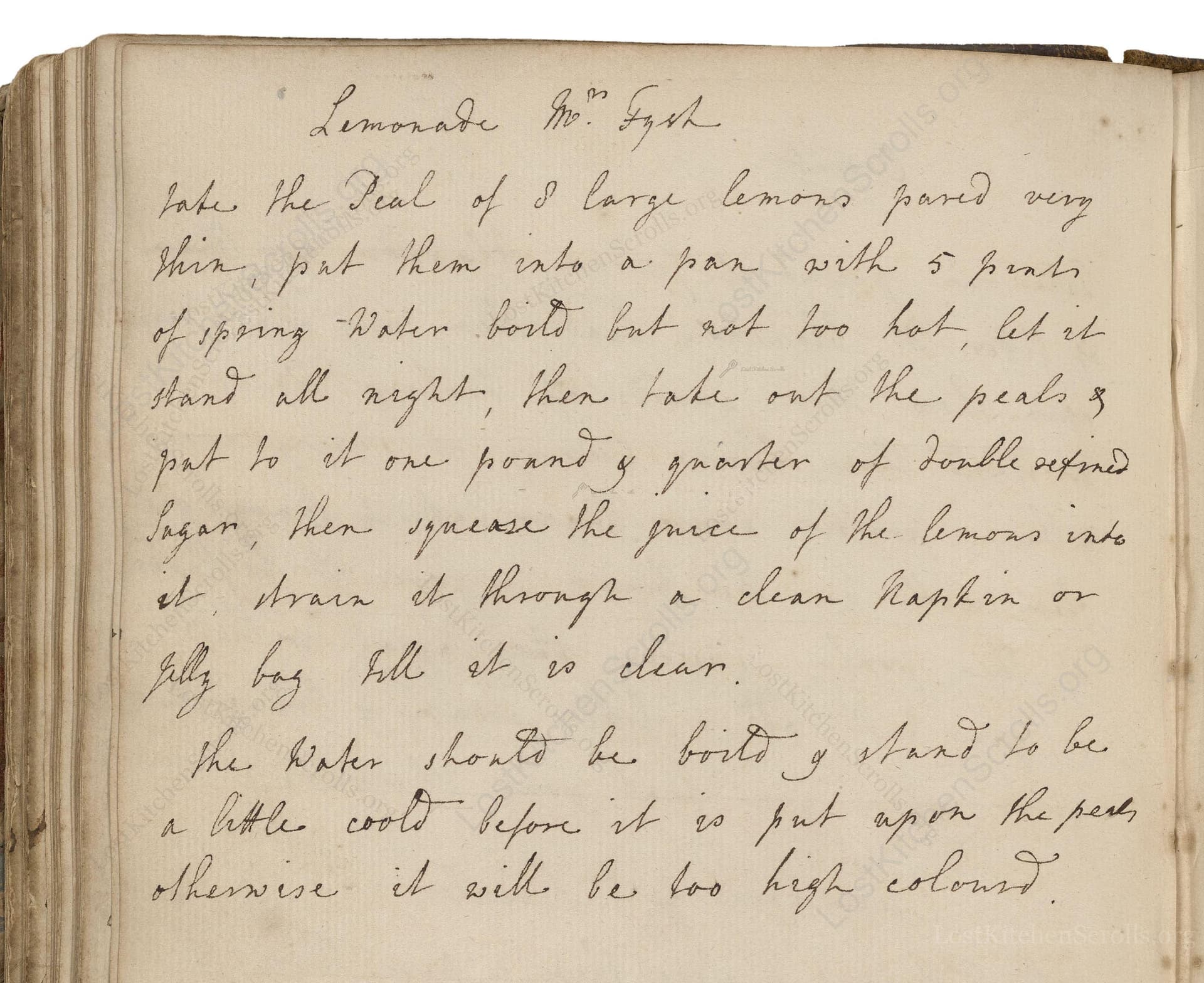Lemonade Mr. Egst
From the treasured pages of Cookbook of Elizabeth Langley
Written by Elizabeth Langley

Lemonade Mr. Egst
"Take the Peal of 8 large lemons pared very thin, put them into a pan with 5 quarts of spring Water boild but not too hot, let it stand all night, then take out the peals, & put to it one pound & quarter of double refind Sugar, then squeeze the juice of the lemons into it, strain it through a clean Napkin or Jelly bag till it is clear. The Water shoudt be boild & Stand to be a little coold before it is put upon the peals, otherwise it will be too high colourd."
Note on the Original Text
This recipe is concise and practical, using direct instructions without specifying exact times beyond 'overnight' or 'till it is clear'—relying on the cook's judgment. Spelling such as 'Peal' (peel), 'refind' (refined), and 'boild' (boiled) reflects 18th-century orthography before English spelling standardized. Quantities are precise for their time, using weights like 'pound & quarter.' Directions are clear but assume experience handling hot water, sugarwork, and straining liquids—typical for manuscript recipes passed among skilled home cooks of the day.

Title
Cookbook of Elizabeth Langley (1757)
You can also click the book image above to peruse the original tome
Writer
Elizabeth Langley
Era
1757
Publisher
Unknown
Background
Step into the Georgian kitchen with Elizabeth Langley's 1757 culinary collection, where refined techniques and delightful recipes await those with a taste for historic gastronomy.
Kindly made available by
Folger Shakespeare Library
This recipe, recorded by Elizabeth Langley in 1757, comes from an era when lemonade was a fashionable refreshment among the English upper classes. Lemons were valuable imports and using both zest and juice in a drink ensured no part was wasted. The recipe reflects both the luxury of imported citrus and the new enthusiasm for sweet-and-sour beverages, as sugar became increasingly available. In country manor kitchens and townhouses alike, such lemonade would be served at gatherings or tea tables—a cool, aromatic treat in the age before refrigeration.

The recipe would have relied on a good, heavy kitchen knife or peeler to carefully pare the lemon zest without the bitter white pith. A large copper or earthenware pan was used to heat and steep the water and zest. Straining was done through a muslin napkin or a purpose-made jelly bag (akin to a modern nut milk bag). Squeezing lemons relied on hand strength and possibly a wooden reamer or press. Sugar would be added and mixed in large wooden or ceramic bowls or pans, ideally with a long-handled spoon for dissolving.
Prep Time
20 mins
Cook Time
0 mins
Servings
10
We've done our best to adapt this historical recipe for modern kitchens, but some details may still need refinement. We warmly welcome feedback from fellow cooks and culinary historians — your insights support the entire community!
Ingredients
- 8 large lemons (for zest and juice)
- 5 quarts spring water (or filtered water)
- 1 1/4 pounds caster sugar (substitute: superfine sugar if unavailable)
Instructions
- Take the zest (the thinly pared yellow outer skin) of 8 large lemons and place them in a bowl.
- Heat 5 quarts of fresh water just to boiling, then cool it slightly so it's hot but not boiling, and pour over the lemon zest.
- Let this steep overnight at room temperature.
- The next day, remove the zest.
- Add 1 1/4 pounds of caster sugar to the lemon-infused water and stir to dissolve.
- Squeeze the juice from the 8 lemons into the water.
- Strain the mixture through a fine clean cloth or jelly bag until it runs clear.
- Chill before serving for a refreshing, delicate lemonade.
Estimated Calories
120 per serving
Cooking Estimates
It takes about 20 minutes to zest and juice the lemons and mix the ingredients, then you let the lemon zest steep in hot water overnight. The lemonade serves 10 people, and each serving has about 120 calories.
As noted above, we have made our best effort to translate and adapt this historical recipe for modern kitchens, taking into account ingredients nowadays, cooking techniques, measurements, and so on. However, historical recipes often contain assumptions that require interpretation.
We'd love for anyone to help improve these adaptations. Community contributions are highly welcome. If you have suggestions, corrections, or cooking tips based on your experience with this recipe, please share them below.
Join the Discussion
Rate This Recipe
Dietary Preference
Main Ingredients
Culinary Technique
Occasions

Den Bockfisch In Einer Fleisch Suppen Zu Kochen
This recipe hails from a German manuscript cookbook compiled in 1696, a time whe...

Die Grieß Nudlen Zumachen
This recipe comes from a rather mysterious manuscript cookbook, penned anonymous...

Ein Boudain
This recipe comes from an anonymous German-language manuscript cookbook from 169...

Ein Gesaltzen Citroni
This recipe, dating from 1696, comes from an extensive anonymous German cookbook...
Browse our complete collection of time-honored recipes



